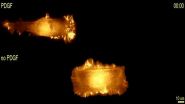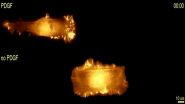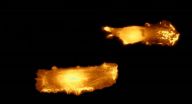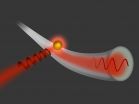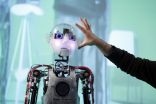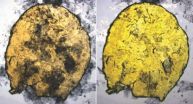(Press-News.org) VIDEO:
The cell stimulated with the growth factor PDGF (upper cell) migrates targeted in only one direction on its track, while the not stimulated cell (lower cell) changes its direction of...
Click here for more information.
During cancer metastasis, immune response or the development of organisms, cells are moving in a controlled manner through the body. Researchers from the Department of Biomedicine at the University of Basel discovered novel mechanisms of cell migration by observing cells moving on lines of connective tissue. Their results, published in the journal Developmental Cell, could lead to new approaches in combatting cancer metastasis and inflammation.
Cells migrate by connecting their cytoskeleton – a network made up of proteins – to adhesion molecules which in turn get in contact with the surrounding connective tissue. In order to guide cells in a certain direction a signal from outside is needed, which leads then to cell polarization and coordinated mechanical movement. A fundamental question is how signaling pathways are regulated in time and space to facilitate directional migration of cells.
Classical cell migration experiments use uniformly coated glass plates with the drawback that cells adhere very strongly to the glass surface and move randomly in any direction. This random cell movement aggravates comprehensive studies of directional cell migration.
Mimicking organisms
In their study, scientists around Prof. Olivier Pertz from the Department of Biomedicine at the University of Basel gained novel insights into the regulation of directional cell migration: Using a special procedure, 20 micrometer wide lines were fabricated on glass thereby mimicking the connective tissue environment – creating a highway for cells. In addition, cells were stimulated with a growth factor (PDGF) which led to fast cell migration in only one direction lasting for many hours.
"This shows that we can achieve robust and directional cell migration by mimicking the geometry of connective tissue as we find it in the body," tells Olivier Pertz. Certain dot-like structures, that are always located at the front of the cell, adopt a crucial role in maintaining long term polarized cell migration.
The research results give novel insights into how signaling pathways are regulated in time and space in order to facilitate migration of cells only in one direction. The scientists describe novel concepts of cell migration, which could help to find new targets and approaches to fight cancer metastasis and inflammation. "The more insights we get into the mechanisms of cell migration, the more effectively and focused we will be able to intervene in certain pathological processes," first author Dr. Katrin Martin comments.
INFORMATION: END
Basel scientists are bringing cells on the fast track
2014-10-06
ELSE PRESS RELEASES FROM THIS DATE:
Liquid DNA behind virus attacks
2014-10-06
Viruses can convert their DNA from solid to fluid form, which explains how viruses manage to eject DNA into the cells of their victims. This has been shown in two new studies carried out by Lund University in Sweden.
Both research studies are about the same discovery made for two different viruses, namely that viruses can convert their DNA to liquid form at the moment of infection. Thanks to this conversion, the virus can more easily transfer its DNA into the cells of its victim, which thus become infected. One of the studies investigated the herpes virus, which infects ...
Nanoparticles break the symmetry of light
2014-10-06
This news release is available in German.
How can a beam of light tell the difference between left and right? At the Vienna University of Technology (TU Wien) tiny particles have been coupled to a glass fibre. The particles emit light into the fibre in such a way that it does not travel in both directions, as one would expect. Instead, the light can be directed either to the left or to the right. This has become possible by employing a remarkable physical effect – the spin-orbit coupling of light. This new kind of optical switch has the potential to revolutionize ...
Tumors might grow faster at night
2014-10-06
They emerge at night, while we sleep unaware, growing and spreading out as quickly as they can. And they are deadly. In a surprise finding that was recently published in Nature Communications, Weizmann Institute of Science researchers showed that nighttime is the right time for cancer to grow and spread in the body. Their findings suggest that administering certain treatments in time with the body's day-night cycle could boost their efficiency.
This finding arose out of an investigation into the relationships between different receptors in the cell – a complex network ...
Researchers redefine hypothesis on holes in the brain
2014-10-06
Over the years, researchers have described how some of the body's cells have giant channels – a kind of holes that completely uncritically allow both small and large molecules to penetrate into and out of the cell. The hypothesis is that these normally closed gatekeeper proteins in the cell membrane allow unrestricted access in the event of diseases such as myocardial infarction, stroke or Alzheimer's. If the hypothesis was correct, the obvious choice would be to look for novel drugs to block the relevant membrane proteins and in this way cure or prevent disease.
New ...
Tracing our ancestors at the bottom of the sea
2014-10-06
A specialist group of European researchers are studying the remains of prehistoric human settlements which are now submerged beneath our coastal seas. Some of these drowned sites are tens of thousands of years old. From the progressive discovery and analysis of these prehistoric remains, a new scientific field has emerged, combining the expertise from many disciplines including archaeology, oceanography and the geosciences. The new field is called Continental Shelf Prehistoric Research.
This rapidly evolving research field is the focus of a new European Marine Board ...
MFM specialists contribute to Clinical Expert Series in Obstetrics & Gynecology
2014-10-06
Since the first human fetal surgery was reported in 1965, several different fetal surgical procedures have been developed and perfected, resulting in significantly improved outcomes for many fetuses. However, the significant investments associated with this highly specialized service and quality metrics must be considered as more fetal treatment programs are developed.
Katharine D. Wenstrom, MD, director of the Division of Maternal-Fetal Medicine at Women & Infants Hospital of Rhode Island, co-director of the hospital's Integrated Program for High-Risk Pregnancy, and ...
Why does toothpaste make orange juice taste awful? (video)
2014-10-06
WASHINGTON, Oct. 6, 2014 — It's happened to many of us: Half asleep in the morning, you finish brushing your teeth and reach for your daily glass of orange juice. After taking a big swig, you spit it back out, making a face like you've just chewed on a lemon. Turns out, a specific chemical in your toothpaste is responsible for that nasty taste. This week, Reactions explains why toothpaste and orange juice don't mix. Learn all about it at https://www.youtube.com/watch?v=9X5_gtel-c0.
Subscribe to the series at Reactions YouTube, and follow us on Twitter @ACSreactions to ...
Pressing the accelerator on quantum robotics
2014-10-06
Quantum computing will allow for the creation of powerful computers, but also much smarter and more creative robots than conventional ones. This was the conclusion arrived at by researchers from Spain and Austria, who have confirmed that quantum tools help robots learn and respond much faster to the stimuli around them.
Quantum mechanics has revolutionised the world of communications and computers by introducing algorithms which are much quicker and more secure in transferring information. Now researchers from the Complutense University of Madrid (UCM) and the University ...
A glimpse into the 3-D brain: How memories form
2014-10-06
The way neurons are interconnected in the brain is very complicated. This holds especially true for the cells of the hippocampus. It is one of the oldest brain regions and its form resembles a see horse (hippocampus in Latin). The hippocampus enables us to navigate space securely and to form personal memories. So far, the anatomic knowledge of the networks inside the hippocampus and its connection to the rest of the brain has left scientists guessing which information arrived where and when.
Signals spread through the brain
Accordingly, Dr Martin Pyka and his colleagues ...
No need for water, enzymes are doing it for themselves
2014-10-06
New research by scientists at the University of Bristol has challenged one of the key axioms in biology - that enzymes need water to function. The breakthrough could eventually lead to the development of new industrial catalysts for processing biodiesel.
Enzymes are large biological molecules that catalyse thousands of different chemical reactions that are essential for all life, from converting food into energy, to controlling how our cells replicate DNA.
Throughout this diverse range of biological environments in which enzymes perform their various roles, the only ...
